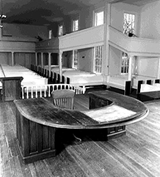E N I G M A
Where "The New South" was born
Tucked away in a corner of Oxford College's Old Church, in a small room known locally as "The Museum," dust and cobwebs veil a rich store of Emory history. A narrow path snakes among the tangle of antique tables and chairs, portraits of Emory presidents past, a spinning wheel that reportedly belonged to the mother of a mid-nineteenth-century trustee, and a creaky display case full of Commencement programs more than a century old.
Inevitably, visitors are drawn to the most imposing object in the room--a massive, U-shaped mahogany desk. Although it appears to be little more than a curiosity from a bygone age and home to the occasional spider, the desk holds a significant place in American history. A set of notions that would help transform the late-nineteenth-century South was conceived on its worn, scarred surface.
A small brass plate on the left side of the desk states that it was made for Atticus Greene Haygood, Emory's president from 1875 to 1884. The desk's unusual construction features ornate carved mahogany brackets in each corner, a removable writing surface that slopes downward to the right, and myriad cabinets and cubbyholes. According to the recollections of Haygood's youngest daughter, Laura Haygood Watts, "Drawers on each side [of the desk were] for manuscripts and little doors for places for books of reference. . . . He was very particular about that desk. He alone was the one to straighten it out."
In the waning years of Reconstruction, Methodist Bishop Haygood, an 1859 Emory College graduate and its eighth president, wrote and spoke extensively on the tenuous but hopeful state of his region. The most famous of his writings was his Thanksgiving Day 1880 sermon, "The New South," which focused on the improving financial condition and the challenges of race relations in the South in the decades following the Civil War. "I, for one, thank God that there is no longer slavery in these United States," Haygood said in his sermon. "It is better for our industries and our business, as proved by the crops that free labor makes."
A copy of the address later landed in the hands of New York banker George I. Seney. He was so moved by it that even though he had never laid eyes on the College or Haygood, he gave Emory $130,000. The gift provided stability for the College in a time of great financial peril.
But Haygood's oration resonated in other ways less often recounted. In 1886, Henry W. Grady, renowned editor of the Atlanta Constitution and unofficial spokesman for the ideals of the post-Reconstruction South, delivered his famous address to the New England Society of New York--an oration also titled "The New South." Although the phrase "The New South" predated even Haygood in the writings of Georgia statesman Benjamin H. Hill, Grady drew upon the rhetoric and ideas his good friend Haygood had penned on the mahogany desk in Oxford.
Grady's speech made him a national sensation virtually overnight. While he is widely credited with helping bring about Southern industrial development, especially through Northern investment, he never forgot his debt to Haygood's earlier work, proclaiming, "I lighted my torch at Haygood's flame."
Haygood resigned the Emory presidency in 1884 to give full attention to his work as agent of a Connecticut-based fund for burgeoning Southern colleges for African Americans. The desk where "The New South" was born was given to Oxford fifty-six years later when another daughter, Mamie Haygood Ardis, presented it to the town. It was placed in storage until funds for its restoration and a proper setting for its display could be attained, and it has remained there since.
"When we first put it in [the Old Church], we intended to burnish it up a little," says Marshall Elizer, professor emeritus of mathematics and member of the Oxford Historical Shrine Society. "But you know how that sort of thing goes."--A.O.A.
Return to Summer 1998 contents page
